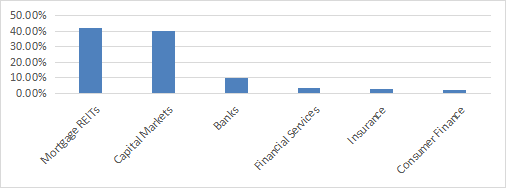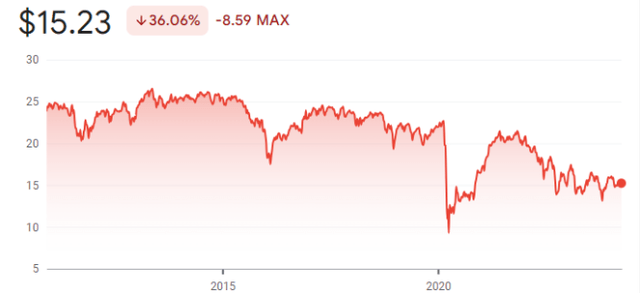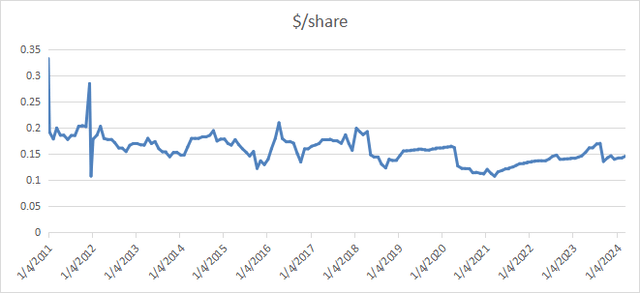This article series aims at evaluating ETFs (exchange-traded funds) regarding past performance and portfolio metrics. Reviews with updated data are posted when necessary.
KBWD strategy
Invesco KBW High Dividend Yield Financial ETF (NASDAQ:KBWD) started investing operations on 12/02/2010 and tracks the KBW Nasdaq Financial Sector Dividend Yield Index. It has 41 holdings (including cash) and a 30 Day SEC Yield of 11.37%. Management fees are 0.35%, but the total expense ratio including holding expenses is 2.02%. Distributions are paid monthly.
As described in the prospectus by Invesco, the underlying index…
…is a modified-dividend yield-weighted index of companies principally engaged in the business of providing financial services and products (…) which may include business development companies and real estate investment trusts.
Eligible stocks must be listed on a U.S. exchange and:
- be classified in financial services and products;
- have a minimum float of 20%;
- have a minimum average daily trading volume of 100,000 shares;
- pay a regular dividend;
- have a minimum closing price of $5.
The portfolio turnover rate in the most recent fiscal year was 68%.
KBWD portfolio
The fund invests exclusively in U.S. based companies, mostly in small and micro caps (about 94% of asset value). The heaviest industries in the portfolio are mortgage REITs and capital markets: they weigh about 42% and 40% of assets, respectively. Capital markets include a number of BDCs (business development companies). It means over 80% of asset value (mortgage REITs and BDCs) is in leveraged non-rated debt.

Industry breakdown (Chart: author; data: Fidelity)
The next table lists the top ten holdings with their weights and dividend yields. The portfolio is quite concentrated: their aggregate weight is about 35.1%. However, risks related to individual companies are moderate: the maximum exposure to a single constituent is below 4%.
|
Ticker |
Name |
% of Assets |
Category |
IAD Yield % |
|
EFC |
Ellington Financial, Inc. |
3.93 |
mortgage REIT |
13.71 |
|
AGNC |
AGNC Investment Corp. |
3.75 |
mortgage REIT |
14.91 |
|
FSK |
FS KKR Capital Corp. |
3.71 |
BDC |
14.55 |
|
ARR |
ARMOUR Residential REIT, Inc. |
3.52 |
mortgage REIT |
14.81 |
|
RILY |
B. Riley Financial, Inc. |
3.42 |
Misc. Services |
8.55 |
|
TWO |
Two Harbors Investment Corp. |
3.41 |
mortgage REIT |
14.57 |
|
NLY |
Annaly Capital Management, Inc. |
3.38 |
mortgage REIT |
13.52 |
|
TRIN |
Trinity Capital, Inc. |
3.37 |
Loans |
14.80 |
|
RC |
Ready Capital Corp. |
3.33 |
mortgage REIT |
13.64 |
|
FDUS |
Fidus Investment Corp. |
3.26 |
BDC |
14.85 |
Performance
Since 1/1/2011, KBWD has lagged the sector benchmark Financial Select Sector SPDR Fund (XLF) by 5.3 percentage points in annualized return. Moreover, it shows a significantly higher risk, measured in maximum drawdown and standard deviation of monthly returns (“volatility” in the next table).
|
Total Return |
Annual.Return |
Drawdown |
Sharpe ratio |
Volatility |
|
|
KBWD |
110.41% |
5.77% |
-58.63% |
0.33 |
22.19% |
|
XLF |
302.93% |
11.08% |
-42.86% |
0.6 |
19.06% |
Data calculated with Portfolio123
The share price history, plotted below, shows that KBWD has suffered a total capital decay of 36% since inception. Moreover, the cumulative inflation has been about 41% in the same time (based on CPI), resulting for shareholders in a very large loss in inflation-adjusted value.

KBWD since inception, price return (Google Finance)
The monthly distribution seems to be slowly trending down on the long term, as plotted on the next chart. Nevertheless, it has increased over the last 3 years.

KBWD distribution history (Chart: author; data: Invesco)
Capital and distribution decay is not specific to KBWD: securities with yields above 6% suffer from capital decay on average (there are rare exceptions).
My dividend ETF reviews usually report aggregate value and quality metrics. It is possible to calculate them for KBWD, but it makes little sense. Usual ratios are unreliable in the financial sector, especially for mortgage REITs and BDCs.
Takeaway
Invesco KBW High Dividend Yield Financial ETF holds 40 stocks of high yield financial companies. Over 80% of assets is invested in two industries whose business model is based on non-rated debt: mREITs and BDCs. The yield looks very attractive for income-oriented investors, but KBWD data point to at least four red flags: expense ratio, historical volatility, capital decay, and long-term distribution decay. KBWD may be suitable for swing trading, but I think it is too risky as a long-term investment.
Read the full article here



